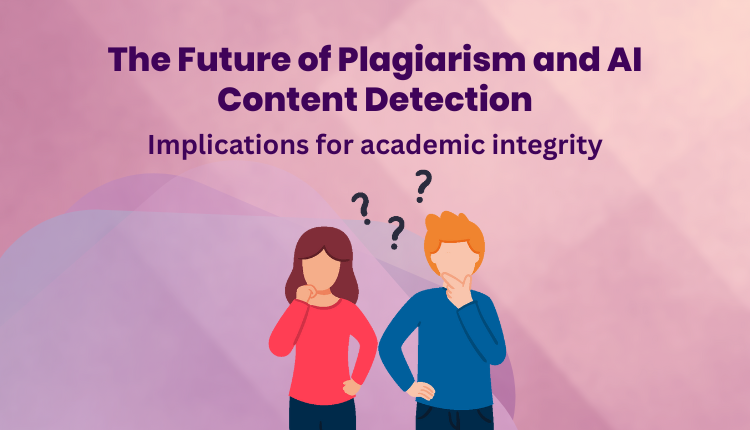The Future of Plagiarism and AI Content Detection: Implications for academic integrity

The rise of artificial intelligence has created an unprecedented crisis in higher education: the line between authentic student work and AI-generated content has become nearly invisible. Traditional plagiarism detection tools now stand ill-equipped to handle sophisticated AI systems that produce nuanced, contextually appropriate text indistinguishable from human thought.
Universities are now struggling to navigate through these waves of un- expected updates; they are facing a stark choice—evolve their integrity frameworks or watch them crumble under undetectable misconduct. The solution lies not in banning AI, but in developing transparent systems that restore trust between educators and students while preserving the fundamental value of authentic learning.
AI’s impact on academic integrity
Large language models have changed how we think about academic research and what counts as original work. Traditional rules about plagiarism and copying are now unclear because it’s hard to tell the difference between human thinking and AI assistance.
Academic integrity used to have clear boundaries, but AI has made those lines blurry. Researchers now face new questions about what constitutes authentic scholarship when AI can help generate ideas, text, and analysis.
This paradigm shift has given rise to unprecedented forms of academic misconduct that challenge our conventional understanding of authorship and originality. Source-based plagiarism and sophisticated paraphrasing techniques now exploit the blind spots of traditional detection methods, while AI-generated content masquerades as human thought with alarming sophistication. The academic community finds itself grappling with fundamental questions about the nature of scholarly contribution: What constitutes authentic intellectual work when machines can produce nuanced, contextually appropriate text within minutes?
Limitations of traditional plagiarism detection
Tools designed to identify copy-paste plagiarism are ineffective against the complex and constantly changing nature of content generated by AI. Current detection tools are incapable of identifying writing that reworks ideas or reword source material in innovative manners, capabilities that AI systems are accomplishing with growing complexity. As AI systems become more capable of human-like reasoning and generate complex academic work, educational institutions are confronted with a pressing issue: differentiating between genuine AI-assisted work and academic dishonesty, where the technology mimics human intelligence.
This evolution demands immediate deployment of advanced detection solutions capable of identifying AI-generated content, sophisticated paraphrasing, and hybrid human-AI collaborations. The academic community must rapidly develop new plagiarism detection frameworks or risk widespread undetectable misconduct that undermines scholarly integrity. The stakes are no longer just about catching copied text—they involve preserving the fundamental credibility of academic institutions against AI-assisted fraud that traditional detection methods simply cannot identify.
Documark’s distinctive value proposition
The distinction between genuine student work and content created by artificial intelligence is becoming increasingly blurred, leading to a climate of uncertainty and distrust that undermines the fundamental principles of academic integrity. In acknowledging this crucial challenge, DocuMark—a groundbreaking solution that is transforming how educators and students approach AI-assisted learning- was created. Trinka AI’s cutting-edge tracking system functions smoothly in the background, accurately documenting each keystroke, paste action, and interaction with the AI, thereby producing a definitive digital record of the students’ creative process. After students have finished their assignments, DocuMark requires them to inspect and confirm their work, and then produces a comprehensive report that reveals the entire process of creating each piece of content. This report can be instantly shared with professors, giving them a clearer understanding of their students’ work processes without the stress and time-consuming detective work usually associated with verifying plagiarism. This outcome creates a mutually beneficial environment where students can confidently show their academic honesty and educators obtain the tools required to fairly evaluate genuine effort, ultimately rebuilding trust and accountability in the educational process while accepting the advantages of AI as a legitimate learning tool when properly revealed.
Consequences of inadequate detection tools
Universities face a growing crisis without tools like DocuMark. Professors are burning out from manually checking if student work is authentic. Students face constant suspicion and false accusations of AI cheating. This damages their motivation and trust in the academic system.
Students also lack proper guidance on how to use AI ethically. They must figure out academic writing standards on their own. This leads to two problems: some students avoid helpful AI tools out of fear, while others misuse AI and violate academic integrity rules. Both situations hurt learning outcomes.
Universities need DocuMark as essential infrastructure. This investment is now critical for maintaining educational quality and institutional credibility. Delaying this decision puts universities at risk in the AI era, for more information on how you can avoid all of the above-mentioned distress at your university you can drop an email to: support@trinka.ai
